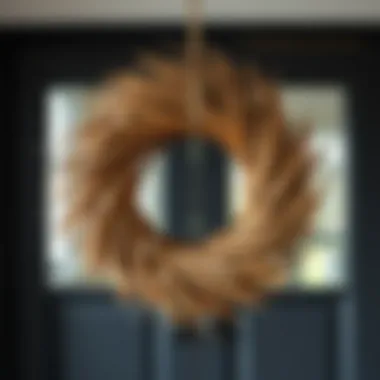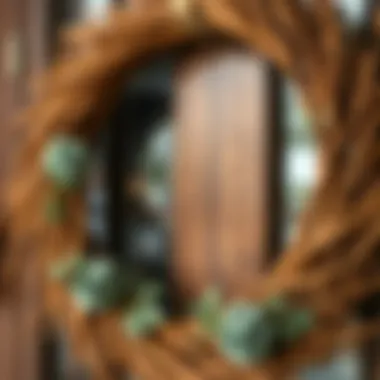Crafting Elegant Wooden Twig Wreaths for Your Home


Intro
Diving into the world of crafting wooden twig wreaths reveals not only a popular form of home décor but also an art that speaks volumes about creativity and individuality. These wreaths, often made from twigs, branches, and other natural materials, embody a connection to nature that many find soothing. Decorating with twig wreaths is more than just an aesthetic choice; it's also an opportunity for personal expression, allowing crafters to infuse their unique style into their living spaces.
Creating a wreath from twigs can appear straightforward, but the art form carries a myriad of techniques, styles, and cultural influences. From intricate designs that highlight seasonal motifs to minimalist styles that embrace simplicity, wooden twig wreaths can suit any taste. Each wreath tells a story; perhaps it symbolizes a season or even a special occasion. It's this personal touch that makes crafting them a rewarding experience, appealing to both novice makers and seasoned artisans alike.
In this exploration, we will analyze the materials essential for crafting these elegant pieces, explore various design ideas, and discuss the cultural significance that may inspire your next project. With careful attention to detail, we aim to guide you through the methodical steps of wreath-making, enriching your understanding and bolstering your skills along the way.
Through this article, we hope to not only arm you with practical tips but also inspire a deeper appreciation for the artistry involved in creating wooden twig wreaths. By the end, you’ll be eager to gather your twigs, let your creativity run wild, and craft something that reflects your personal style.
Prologue to Wooden Twig Wreaths
Wooden twig wreaths have emerged as not just seasonal decorations but as timeless pieces that intertwine nature's beauty with creative expression. These unique creations can symbolize various aspects of life, from welcoming guests to showcasing the changing seasons. Understanding the significance of these wreaths illuminates their role in home décor and personal expression. Crafting these wreaths offers a peaceful retreat from the hustle and bustle, allowing us to engage with nature and craft our own stories.
Defining Wooden Twig Wreaths
Wooden twig wreaths primarily consist of an assemblage of twigs and branches arranged in a circular form, traditionally used to adorn doors and walls. The simplest definition, however, doesn't do justice to the myriad styles and variations that exist. These wreaths can range from minimalistic and elegant designs, using thin, delicate twigs, to robust creations that integrate thick branches, barks, and, occasionally, embellishments like flowers or ribbons. Beyond their appearance, these wreaths can reflect the personal touch of the crafter.
Historical Context and Cultural Relevance
The history of wreaths is both rich and diverse, dating back to antiquity. Originating as ancient symbols of victory, wreaths were once made with laurel leaves, awarded to champions in Greece. Over time, this circular form evolved across various cultures. In European traditions, particularly during festive seasons, wreaths made from evergreens represented eternal life. Furthermore, in many cultures, presenting a wreath signifies welcome and friendship.
"Wreaths are not just decorative; they whisper age-old stories of tradition, warmth, and the cyclicality of nature."
Today, wooden twig wreaths embody this historical essence while embracing contemporary aesthetics. Their versatility has allowed them to be embraced in various contexts—from rustic, country-style homes to modern urban apartments. By crafting these wreaths, one not only creates a piece of art but also connects with a narrative that transcends time and culture.
The Natural Appeal of Wood
Wood holds a unique charm that resonates with many people, making it an attractive material for crafting wreaths. It’s not just about aesthetics; the essence of wood speaks to our connection with nature. The organic feel and diverse textures create a warmth that artificial materials often lack. Notably, wood has a way of grounding a space, offering a fresh breath of the outdoors into one’s home environment. This element of bringing the outside in is what elevates wooden twig wreaths above typical decorative items.
Aesthetic Qualities of Timber
Timber showcases a variety of tones, grains, and patterns that can enhance any decorative theme. Each piece of wood brings its own story, from the rugged bark to the smooth inner core. The beauty of a wooden twig wreath often lies in its imperfections; sometimes a twist or knot can add character and intrigue.
- Color: Natural wood offers shades ranging from light beige to deep browns, blending exceptionally well with seasonal decorations.
- Texture: The surface of twigs, whether coarse or smooth, invites touch, making wreaths not just visual but tactile.
- Versatility: Wooden wreaths can be adorned with various embellishments, such as dried flowers, ribbons, or even seasonal accents, maximizing their visual impact.
All these attributes contribute to why wood is such a favored choice among crafters, resonating deeply with those who appreciate the blend of nature and design.
Sustainable Sourcing Practices
Sustainability has become a significant buzzword in crafting, prompting many to consider where and how wood is sourced. Prioritizing sustainably sourced materials helps crafters connect with the environment on a deeper level. It also allows buyers to make informed decisions about their home décor.
Understanding Reclaimed Wood
Reclaimed wood, salvaged from old buildings, barns, or furniture, comes loaded with history. Its age lends a unique patina and often a richer color than new wood. This not only helps save trees but also prevents good materials from ending up in landfills. Many artists choose reclaimed wood precisely because of its character, knowing that no two pieces will ever be alike.
Key Advantages:
- Eco-friendliness: Using reclaimed wood reduces the demand for new lumber, contributing positively to forest conservation.
- Aesthetic Appeal: The weathered look of reclaimed wood can add depth and authenticity to wreath designs.
- Sustainability: Reclaimed wood often requires less processing, making it an environmentally friendly choice.
The Importance of Eco-Friendly Materials


In the realm of crafting, the movement toward eco-friendly materials is gaining serious traction. Opting for wood sourced from sustainably managed forests can help mitigate damage to ecosystems. Materials that are certified by organizations like the Forest Stewardship Council (FSC) come with assurances that their production doesn’t harm the environment.
Key Characteristics:
- Resource Efficiency: Eco-friendly materials often utilize lesser-known species, which can help disperse harvesting pressures on more popular woods.
- Health Benefits: Non-toxic finishes and varnishes used on eco-friendly materials can create safer products for home use, reducing exposure to harmful chemicals.
- Consumer Value: As the market shifts toward sustainability, products that showcase eco-friendly materials can enhance brand value and consumer loyalty.
Crafting Techniques for Wooden Twig Wreaths
Crafting wooden twig wreaths is an art that combines creativity with an understanding of natural materials. It's not just about putting twigs together; it's about harmonizing elements from nature into tangible designs which can be appreciated in any setting. Having a grasp of the right techniques enhances the crafting experience, allowing for more intricate and personalized wreaths.
Essential Tools and Materials
Types of Twigs and Branches
Selecting the right types of twigs and branches is crucial when making wooden twig wreaths. It influences not just the aesthetic but also the wreath’s durability. You might consider willow, birch, or even dogwood for their flexibility and sturdiness. Each of these woods carries a unique characteristic. For instance, willow twigs bend easily, making them great for creating curves and intricate patterns. On the other hand, birch offers a more robust structure. This variety allows crafters to mix and match to create a standout piece. Choosing well-sourced or reclaimed branches enhances the eco-friendly aspect of crafting, allowing you to create something beautiful while still being kind to Mother Earth.
Tools Needed for Construction
Your toolkit can make or break your crafting session. Essential tools like a good set of pruning shears, wire cutters, and a hot glue gun can expedite the process significantly. Having the right tools allows for precise cuts and secure bonds, ensuring that your wreath remains intact. The pruning shears, for example, make it easier to gather twigs from your garden or local area, while a hot glue gun serves to quickly and effectively hold the various components together. Failing to invest in quality tools might lead to frustration during the crafting process and could diminish the final product’s visual appeal.
Step-by-Step Crafting Process
Preparing the Base Frame
Before diving into the design elements, preparing a solid base frame is essential. This frame serves as the backbone of your wreath and can be made from sturdy twigs bound together. Using a thicker branch as the framework will provide stability, which is necessary for hanging the wreath. A well-structured base ensures that the design is not only visually appealing but also sturdier. It can carry the weight of additional decorations like faux flowers or thin vines, allowing for greater creativity in your designs.
Arranging the Twigs
Once your base frame is set, the next step is arranging the twigs in an aesthetically pleasing manner. This is where your creativity can truly shine. Various arrangements can evoke different feelings or themes; for instance, spreading twigs evenly creates a uniform look, while clustering them can add a more organic and wild feel. To keep everything harmonized, it’s wise to step back occasionally and view your progress from a distance, ensuring a balanced arrangement. Remember, the beauty lies in the details, so don’t rush this part.
Securing Your Design
Finally, securing your design is crucial for its longevity. Using floral wire or a hot glue gun to firmly attach the twigs will ensure that your work doesn’t fall apart at the first touch. The unique feature of floral wire is its ability to blend seamlessly into the natural look of your wreath, making it an ideal choice for securing elements while remaining nearly invisible. A haphazard attachment method could compromise your wreath’s elegance, so take your time to ensure everything is secure before displaying your crafted piece.
Crafting a wooden twig wreath is much more than just artistry; it's a process that fosters mindfulness and a connection with nature.
These crafting techniques not only dictate the quality of the final product but also shape the entire creative experience, turning crafting into a meditative practice rather than a mere task. Engaging in these steps allows crafters to produce unique wreaths that express personal style and adorn home spaces beautifully.
Design Ideas for Wooden Twig Wreaths
Exploring design ideas for wooden twig wreaths opens up a realm of creativity and personal expression. The beauty of these wreaths lies not only in their natural aesthetics but also in their versatility. With each season offering its distinct charm, wreath designs can reflect changing times, seasonal festivities, and individual aesthetics. This section delves into seasonal inspirations and how adding personalized touches can further enhance the beauty and uniqueness of wreaths.
Seasonal Inspirations
Spring Blossoms
When the world begins to stir from its winter slumber, spring blossoms emerge as a vibrant symbol of renewal. These delicate flowers, with their array of colors like soft pastels and bold shades, can bring a fresh touch to wooden twig wreaths. The incorporation of blossoms adds not just beauty but also a feeling of optimism.
One of the key characteristics of spring blossoms is their ephemeral beauty; they are a reminder of nature's cycles. This makes them a popular choice for wreath crafting during this season. Florists often recommend using blooms like tulips, daffodils, or cherry blossoms due to their bright colors and cheerful vibe. One unique feature of spring blossoms is their ability to evoke emotions—think of how they can instantly uplift a space when displayed.
However, one must consider that these blooms are seasonal and may not last long without proper care, so using artificial versions can also be an option to maintain the aesthetic throughout the year.


Autumn Elements
As summer fades to cooler days, autumn elements bring warmth and richness to wreath designs. Think about vibrant oranges, deep reds, and golden yellows that mirror the changing foliage. These colors can be beautifully translated into wooden twig wreaths using materials like pinecones, acorns, and dried leaves.
The key characteristic of autumn elements is their ability to symbolize harvest and abundance. This seasonal aspect makes them a fitting choice, particularly for home décor during harvest festivals like Thanksgiving. The unique feature here is how easily these natural components can blend to create a rustic, warm atmosphere that reflects cozy gatherings.
However, some might find that, unlike spring blossoms, autumn elements can lose their visual allure after a certain point. This is why incorporating dried or preserved materials can be advantageous, allowing a wreath to remain a centerpiece for more extended periods.
Personalized Touches
Adding Natural Accents
One way to elevate a wooden twig wreath is by adding natural accents. These can range from feathers to moss and even small twigs that enhance the wreath's texture and depth. Natural accents create a more organic look and feel to the design, making each piece truly unique.
The benefit of this approach is that it encourages the use of locally sourced and readily available materials. Plus, it allows for a personal touch—a reflection of the maker's personality or cherished memories tied to specific elements. The challenge, however, lies in ensuring that these accents do not overwhelm the base design; balance is key.
Integrating Color Palettes
Integrating color palettes into wooden twig wreaths can transform the aesthetic appeal significantly. Whether it's a monochromatic theme or a vibrant array of colors, the right palette can evoke a particular mood or season. A carefully chosen color scheme allows for a cohesive design that speaks to the creator's intent and the atmosphere they wish to curate.
One notable characteristic of this method is its adaptability—colors can be selected based on various occasions, holidays, or even personal sentiments. The unique feature of integrating color palettes is that it provides the option for seasonal adaptations, allowing a wreath to transition flawlessly from one season to the next. However, one must tread carefully, as an abundance of clashing hues can detract from the natural elegance that defines wooden twig wreaths.
Embracing the art of design in wooden twig wreaths involves not just following trends but genuinely reflecting personal style.
By thoughtfully considering seasonal inspirations and personalized touches, individuals can create wooden twig wreaths that resonate with their aesthetic, transforming a simple craft into a timeless expression of nature's elegance.
Maintenance and Care of Wooden Twig Wreaths
Caring for wooden twig wreaths goes beyond mere aesthetic upkeep; it significantly enhances their lifespan and visual charm. With our world becoming ever more focused on sustainability, understanding how to maintain these natural elements becomes crucial. Not only does proper care prolong the life of the wreath, but it also solidifies your stewardship of nature’s bounty, leading to an awareness of our resources and their management.
Preserving the Integrity of Materials
Maintaining the integrity of the materials in wooden twig wreaths is vital, especially considering their organic nature. Each twig, branch, or twig used is an individual piece that tells a story of its home in the forest. When exposed to harsh environments such as excessive moisture or extreme temperatures, these materials can warp, crack, or fade.
To preserve their original characteristics, select a suitable location for displaying your wreath. Ideally, choose a spot shielded from direct sunlight and adverse weather conditions. Regularly inspecting the wreath for any signs of damage allows for timely interventions, ensuring the twigs and branches retain their appearance.
Best Practices for Long-Lasting Beauty
Implementing best practices ensures that wooden twig wreaths can be cherished for many years.
Storage Recommendations
When not in use, storing wooden twig wreaths properly is paramount. An ideal storage environment is cool, dry, and dark. This prevents moisture-related damage and discourages pests from taking residence among the twigs.
A unique feature of proper storage includes using breathable materials, such as cotton or linen, to wrap the wreath. Unlike plastic, these materials prevent trapping moisture, allowing any residual humidity to escape. While breathable options are popular for storage, one should also consider that they require slightly more effort, as maintaining cleanliness of the storage area is essential.
Cleaning Techniques
Regular cleaning is another fundamental aspect of preserving your wreath’s beauty. This doesn't just refresh its look; it also prevents the build-up of dust or mold which can compromise the wooden materials over time.
A gentle cleaning solution can be made using mild soap and warm water. Using a soft cloth, carefully wipe down each twig, avoiding excess moisture. A unique characteristic here is the use of a fine toothbrush for those hard-to-reach spots where dust might accumulate. While this method is very effective, care must be taken not to apply too much pressure, which can disturb the arrangement of twigs.


In summary, the maintenance and care of wooden twig wreaths revolve around preserving natural materials and employing best practices for their longevity. By understanding how to properly store and clean wreaths, one can ensure they remain vibrant and a centerpiece in home décor for many seasons to come.
"If you take care of your wreaths, they will take care of your homes."
This idea reinforces the mutual relationship between crafts and their caretakers, leading to a continuous cycle of beauty and care that reflects a respect for nature.
The Symbolism of Wreaths Across Cultures
Wreaths hold a profound significance that stretches far beyond mere decoration. Throughout history, they have been used in various cultures as symbols of welcome, unity, and celebration. When you consider crafting a wooden twig wreath, it’s important to recognize how these pieces can convey deeper meanings and serve as emblems of tradition. By understanding the cultural context of wreaths, crafters can enhance not just the visual appeal of their work, but also its emotional resonance.
Wreaths as Symbols of Welcome
A wreath on a door has traditionally been seen as an invitation to enter and partake in the warmth of home. They extend a welcoming spirit, often adorned during different seasons or holidays to signify hospitality. In many cultures, you can find wreaths made of natural materials, such as twigs or flowers, which substitute for more ornate welcome signs.
This gesture of welcoming is universal, yet distinctly personal. For instance, in certain European countries, the circular shape of a wreath symbolizes eternity, signifying that the host wishes comfort and peace to their guests. This practice reflects a range of sentiments—from simple hospitality to deep-seated cultural traditions.
Rituals and Celebrations Involving Wreaths
Wreaths often feature prominently in various rituals and celebrations across the globe. These practices link individuals to their heritage and often mark transitions or commemorate significant life events.
Celebrations in Ancient Civilizations
In ancient times, wreaths were more than decorations; they were integral to ceremonies. For example, in Ancient Greece, laurel wreaths were awarded to victors in athletic competitions, embodying honor and achievement. This association with victory and status not only added prestige but also fostered a sense of community among participants. Wreaths crafted from laurel or olive branches often adorned temples and were used in rites to worship deities, showcasing nature's contribution to spiritual practices.
Such cultural significance of wreaths in ancient civilizations provides a stark contrast to today's modern interpretations. In a way, these ancient customs remind us of the continuity of tradition and how craft can connect us across time and space.
Modern Interpretations
Today, wreaths have evolved to include a range of materials and styles that echo today’s aesthetics, yet many still retain their symbolic meanings. Modern wreath-making often integrates seasonal themes—think charming holiday wreaths or minimalist designs for year-round use. This adaptability appeals to crafters who want to express individuality while also respecting cultural legacies.
A contemporary take on wreaths could involve repurposed materials, demonstrating a commitment to sustainability while adding a unique flair. These modern interpretations invite further exploration into personal expression, allowing wreaths to serve as not only decorative items but also conversational pieces filled with narratives and personal resonance.
"Wreaths are not merely embellishments; they are often imbued with the stories of the cultures that hold them dear."
In essence, understanding the symbolism of wreaths across cultures enriches the crafting experience. As you create your wooden twig wreath, remember that it can carry a narrative of welcome, celebration, or even a nod to ancient traditions that echo through time.
End: The Timeless Nature of Wooden Twig Wreaths
Wooden twig wreaths are more than just decorative pieces hanging on a door; they embody an artistry that bridges nature with personal expression. These unique creations serve as a reminder of our connection to the natural world, offering warmth and charm to any setting. As trends shift in home décor, the allure of wooden twig wreaths remains strong, capturing the hearts of those who appreciate craftsmanship and sustainability.
Encouragement for Personal Crafting
Engaging in the craft of creating wooden twig wreaths can be incredibly fulfilling. It’s not only about the finished product but also the journey of creation. The act of selecting twigs, finding inspiration in your environment, and handcrafting something unique can be therapeutic. Whether you’re a seasoned artisan or a complete novice, there’s no shortage of opportunities for personal exploration through this craft.
When setting out to create your own wreath, embrace the imperfections and organic shapes of the natural materials you choose. Remember that each wreath tells a story, reflecting your personality and style. Get your hands dirty by exploring workshops or online tutorials that emphasize hands-on techniques. This encourages creativity, making every piece distinctly yours. You might even find joy in hosting crafting sessions with friends or family, turning this practice into a cherished social activity.
Reflections on Aesthetic and Meaning
The aesthetic appeal of wooden twig wreaths lies in their simplicity and organic charm. They invite nature into our spaces, grounding us in a world that often feels disconnected from the environment. The natural textures of the twigs, alongside the colors varying from deep browns to lighter tones, evoke a sense of calm and tranquility.
Understanding the meaning behind wreaths offers further depth. Historically, wreaths symbolize welcome and celebration, carrying a significance that transcends cultures. They mark seasonal changes, honor eternal cycles of life, and often adorn spaces during special occasions. By incorporating elements that are personally meaningful—like flowers from your garden or twigs from a cherished family hike—you can elevate the emotional resonance of your creation.
"Crafting isn’t merely a hobby; it’s a way to touch the earth and celebrate its gifts."
For those who are interested in learning more about the significance and history of wreaths, you can explore further at Wikipedia or Britannica.
Embrace this art—you might find it a gateway to not just beautifying your home but also enhancing your appreciation for nature.







